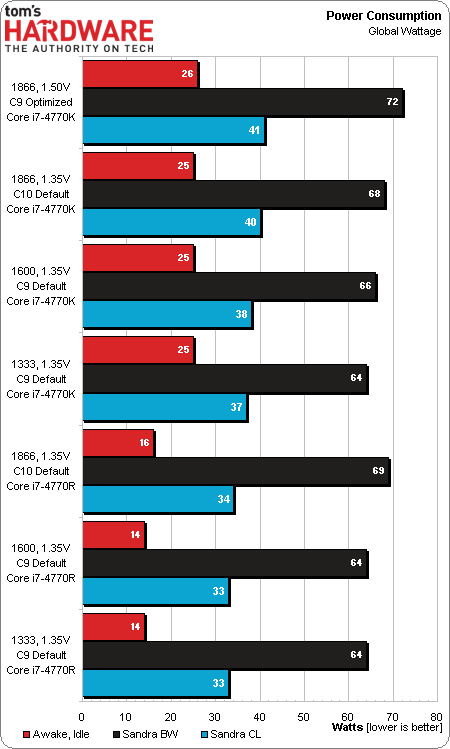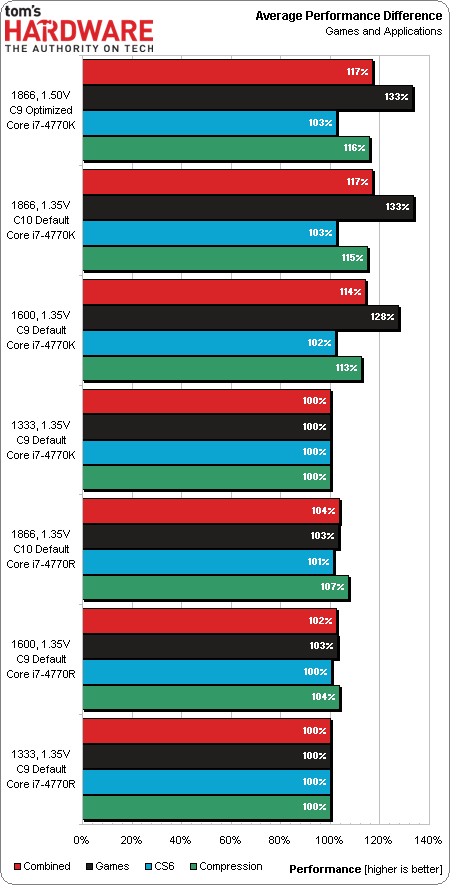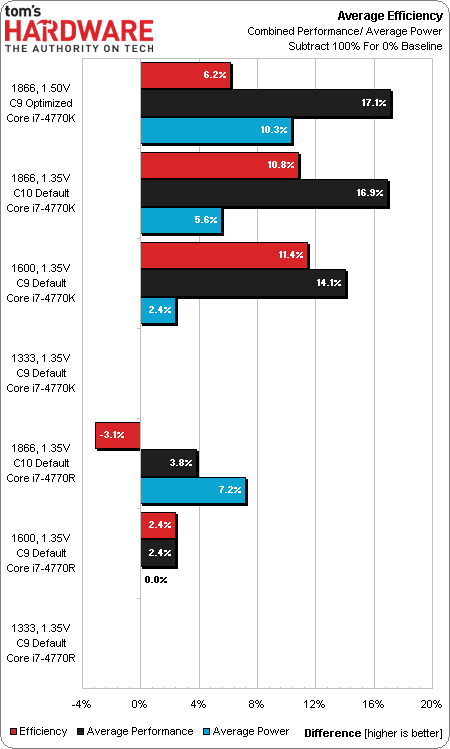Haswell And 1.35 V Memory: Three DDR3 SO-DIMM Kits, Tested
When it comes to memory, most of our focus is on the desktop and its replaceable CPUs. The mobile side typically moves slower. But Intel's Haswell architecture imposes interesting changes, and we saw fit to test SO-DIMMs down at their new 1.35 V ceiling.
Power, Efficiency, And Final Thoughts
Continuous testing showed a one to four watt difference between 1.50 and 1.35 volt memory settings. This difference remained consistent through all speeds, though it’s only shown for the latency-optimized setting. Data rate appears to have a larger effect on memory power consumption, but only when the RAM is loaded and unloaded at unrealistic capacity levels.
We were hoping that the Core i7-4770K could realistically represent the BGA-based Core i7-4770R at both voltage levels, but that’s just not the situation. The LGA 1150-based CPU enjoys a performance jump averaging 17% in the transition from DDR3-1333 to DDR3-1866. The same data rate increase only affected the Core i7-4770R by a mere 4%.
You may have noticed that we have two baselines in the charts. That's an important fact, particularly when you look at the efficiency calculations. Both platforms compare the efficiency of DDR3-1866 and DDR3-1600 results to their own DDR3-1333 baseline.
The embedded platform with Intel's Core i7-4770R becomes 2.4% more efficient at DDR3-1600, but a jump in power demand drops its DDR3-1866 result to sub-baseline levels. The socketed Core i7-4770K also enjoys its highest efficiency at DDR3-1600, but stepping up to DDR3-1866 helps performance enough to partly offset increased power consumption.
Our performance data tells us that the best market for fast SO-DIMMs is likely compact machines with LGA 1150-based CPUs, even though the memory form factor is more specifically intended for notebooks, many of which instead employ low-voltage processors soldered down. Power measurements further specify that low-latency DDR3-1600 is the best memory for our specific Core i7-4770R-based platform.
Switching our attention over to graphics performance, it was more startling to compare HD Graphics 4600 to Iris Pro graphics 5200 than it was to gather the memory-oriented benchmarks, warranting further exploration. It'll be more difficult to explain why the -4770R saw so much less benefit from higher data rates than the -4770K. Further testing of the embedded system would require me to acquire a Core i7-4930MX model that’s otherwise identically equipped.
Get Tom's Hardware's best news and in-depth reviews, straight to your inbox.
Current page: Power, Efficiency, And Final Thoughts
Prev Page Results: File Compression-
Jaroslav Jandek ReplyIt'll be more difficult to explain why the -4770R saw so much less benefit from higher data rates than the -4770K.
The R version has 128MB of L4 cache. At 1280x720, it is large enough for all index and vertex buffers and most textures. That is why main memory speed doesn't significantly affect Iris Pro 5200... -
InvalidError Having 128MB L4 cache certainly skews things around for IGP performance, no surprise there.Reply -
mouse24 Huh, fairly surprised I didn't know about the 1.35v requirement. What happens if you pop in 1.5v in there? Is this just a power savings thing or did intel really mess with their memory controller for laptops?Reply -
Isaiah4110 Wow! I know this article is about memory, but the game benchmark data for Iris Pro actually impresses me quite a bit!Reply -
Crashman Reply
Tell one of these companies that makes upgrade processors to solder the 4770R on an 1150 adapter :)12435372 said:Intel really should've made socketed cpus with Iris Pro
-
zodiacfml AMD must have been very envious with this Iris Pro having embedded 128MB of fast memory....which should be plenty useful for their AMD's APUs.Reply -
de5_Roy Reply
intel claims that the edram costs around $80. that'd jack the a10 6800k price over $200 only to benefit the igpu (possibly the same with gddr5). imo, the weaker cpu cores wouldn't benefit much, if at all. that'd make the apus of poor value and people will argue against the apus claiming you can have a faster configuration under $200 (e.g. core i3 4110/fx6300 + radeon 7770/7750) without requiring the edram. as for core i7 4770R (and other R skus) - it's way too expensive. afaik, brix pro is barebones, the whole pc might cost near $800-1000 fully configured.12436339 said:AMD must have been very envious with this Iris Pro having embedded 128MB of fast memory....which should be plenty useful for their AMD's APUs.



